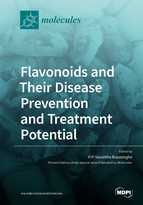Flavonoids and Their Disease Prevention and Treatment Potential
A special issue of Molecules (ISSN 1420-3049). This special issue belongs to the section "Natural Products Chemistry".
Deadline for manuscript submissions: closed (25 September 2020) | Viewed by 116197
Special Issue Editor
Interests: dietary antioxidants; phytochemicals; polyphenols; flavonoids and their derivatives; chemoprevention; molecular mechanisms of action; DNA damage signaling and DNA repair; postbiotics of polyphenols
Special Issues, Collections and Topics in MDPI journals
Special Issue Information
Dear Colleagues,
In recent years, the interest in flavonoids as dietary bioactives to prevent human diseases, as well as their candidacy as pharmaceuticals, has been exponentially expanded. Flavonoids are a subclass of plant polyphenols that have been shown to possess numerous health-promoting properties in a wide range of investigations, from cell-based assays to epidemiological and human intervention studies.
Flavonoids are ubiquitously present in plant-based foods, traditional herbal remedies, and natural health products. Scientific evidence has strongly shown that regular intake of dietary flavonoids reduces the risk of oxidative stress- and chronic inflammation-mediated pathogenesis of human diseases, such as cardiovascular disease, certain cancers, and neurological disorders. The physiological benefits of dietary flavonoids have been demonstrated to be due to multiple mechanisms of action, including regulating redox homeostasis, epigenetic regulations, activation of survival genes and signaling pathways, regulation of mitochondrial function and bioenergetics, and modulation of inflammation response. The role of flavonoids on gut microbiota and impact of microbial metabolites of flavonoids on optimal health has begun to unravel. The complex biological activities of flavonoid molecules are due to their structural diversity. However, some flavonoids are not absorbed well, and their bioavailability could be enhanced through structural modifications and application of nanotechnology such as encapsulation.
Therefore, this Special Issue is dedicated to original research articles which cover the latest findings on the role of dietary flavonoids and their derivatives in disease prevention and treatment. Review articles could discuss the advancement of our knowledge within the mechanisms of action of specific flavonoids, the interaction of flavonoids with microbiota, the enhancement of flavonoid bioavailability and bio-efficacy, etc.
Prof. Dr. Vasantha Rupasinghe
Guest Editor
Manuscript Submission Information
Manuscripts should be submitted online at www.mdpi.com by registering and logging in to this website. Once you are registered, click here to go to the submission form. Manuscripts can be submitted until the deadline. All submissions that pass pre-check are peer-reviewed. Accepted papers will be published continuously in the journal (as soon as accepted) and will be listed together on the special issue website. Research articles, review articles as well as short communications are invited. For planned papers, a title and short abstract (about 100 words) can be sent to the Editorial Office for announcement on this website.
Submitted manuscripts should not have been published previously, nor be under consideration for publication elsewhere (except conference proceedings papers). All manuscripts are thoroughly refereed through a single-blind peer-review process. A guide for authors and other relevant information for submission of manuscripts is available on the Instructions for Authors page. Molecules is an international peer-reviewed open access semimonthly journal published by MDPI.
Please visit the Instructions for Authors page before submitting a manuscript. The Article Processing Charge (APC) for publication in this open access journal is 2700 CHF (Swiss Francs). Submitted papers should be well formatted and use good English. Authors may use MDPI's English editing service prior to publication or during author revisions.
Keywords
- Flavonoids and their derivatives
- Chronic and metabolic diseases
- Prevention and treatment
- Mechanisms of action
- Functional foods and nutraceuticals
- Drug discovery







